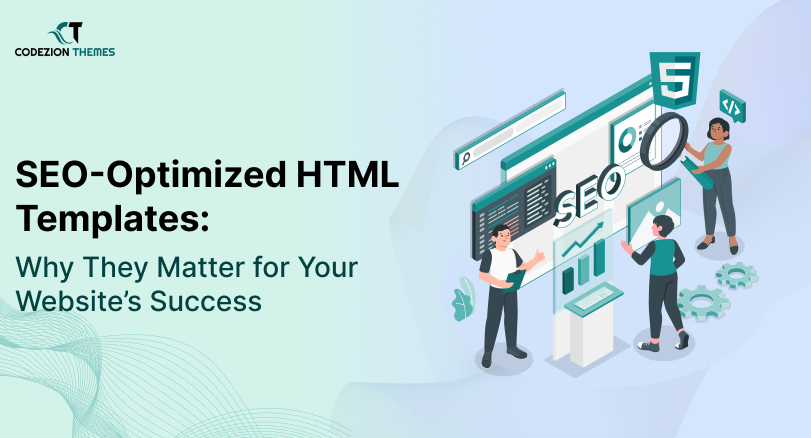SEO Optimized HTML Templates: Why They Matter for Your Website’s Success

In today’s competitive digital environment, simply having a website is not enough. If your site doesn’t rank well in search engines, it might never reach its intended audience. That’s where SEO-optimized HTML templates come in. These are pre-designed website layouts built with search engine optimization best practices in mind. They are structured to improve your website's visibility, speed, and user experience.
Whether you are building a personal blog, business site, or online portfolio, selecting an SEO-friendly HTML template can significantly improve your chances of ranking higher in search engine results pages (SERPs). In this blog, we'll explore what makes an HTML template SEO-optimized, why it's essential, and how to choose the right one for your needs.
What Are SEO-Optimized HTML Templates?
An SEO-optimized HTML template is a ready-to-use website layout built using clean and semantic HTML code that aligns with SEO best practices. These templates are specifically designed to ensure that search engines can easily crawl, index, and understand your website content.
They typically include features like:
- Clean and semantic HTML5 structure
- Mobile-responsive design
- Optimized meta tags
- Fast loading times
- Proper heading hierarchy
- Accessible navigation
These foundational elements are crucial for technical SEO and help improve a website’s overall performance.
Benefits of Using SEO-Optimized HTML Templates
Improved Search Engine Rankings
SEO-friendly templates are coded with proper HTML structure, which allows search engines like Google to better interpret the content of your site. With better indexing, your pages have a higher chance of ranking well in SERPs.
Faster Website Performance
Page speed is a confirmed Google ranking factor. Well-optimized templates reduce unnecessary code, utilize minified scripts, and ensure that assets such as images are compressed, leading to faster page load times.
Mobile Responsiveness
A responsive design ensures that your site adapts to various screen sizes, offering a consistent user experience across desktops, tablets, and smartphones. Mobile-friendliness is another important ranking factor for Google.
Enhanced User Experience
An SEO-optimized template doesn’t just cater to search engines—it also improves the user experience with clean navigation, intuitive design, and fast-loading pages, all of which help reduce bounce rates and increase engagement.
Easier Customization
Most SEO HTML templates are modular and well-documented, allowing developers to customize the design and content easily without breaking SEO functionality.
Key Features to Look For in SEO-Optimized HTML Templates
Not all HTML templates offer the same level of optimization. When choosing one for your website, look for the following features:
Semantic HTML5 Markup
The template should use semantic HTML elements such as, and. This improves accessibility and helps search engines better understand your content structure.
Clean, Valid Code
The template should be compliant with W3C standards. Clean code ensures your site runs efficiently, loads quickly, and avoids compatibility issues across browsers.
Meta Tag Support
A good template allows you to easily insert custom meta titles, descriptions, and keywords. These tags are critical for helping search engines understand what your content is about.
Responsive Design
Ensure that the template adjusts automatically to different screen sizes. Use demo previews to check compatibility with various devices.
Optimized CSS and JavaScript
Check if the template uses minified stylesheets and scripts. Lazy loading of images and asynchronous loading of scripts are also good signs of optimization.
Structured Data Markup
Some templates include Schema.org markup, which helps search engines provide rich results such as star ratings, prices, and event times.
Internal Linking Support
Good templates should include an easy-to-navigate structure that allows for internal linking. This helps both users and search engines discover more of your content. For example, linking to your main HTML Templates category can help pass link equity and improve visibility for related pages.
How to Choose the Right SEO HTML Template
Determine Your Website’s Purpose
Identify whether you are creating a portfolio, a blog, an e-commerce site, or a corporate website. Choose a template that aligns with your objective and includes the right features.
Analyze Live Demos
Always test the live demo of the template on desktop and mobile devices. Evaluate responsiveness, loading speed, and layout quality.
Check Code Quality
Inspect the HTML code of the demo or ask for developer documentation. Look for properly nested tags, appropriate use of heading tags (H1–H6), and well-structured divs.
Browser Compatibility
Your chosen template should be tested across major web browsers like Chrome, Firefox, Safari, and Microsoft Edge to ensure consistent performance.
Customization Options
Choose a template that allows you to easily update images, text, color schemes, and layout elements. Templates that support modular components are easier to scale and maintain.
Best Practices for Using SEO-Optimized HTML Templates
Even the best template needs proper implementation. Follow these best practices to make the most of your SEO-friendly design:
Update Meta Tags for Each Page
Don’t rely on default placeholders. Write unique, keyword-rich meta titles and descriptions for each page.
Optimize Images
Use compressed images in WebP or JPEG formats. Assign descriptive alt tags to each image to improve accessibility and image search rankings.
Use Headings Strategically
Only one H1 tag should be used per page (typically for the main title). Subheadings should follow a logical structure (H2, H3, etc.).
Add Schema Markup
Where applicable, integrate structured data using JSON-LD to help search engines understand your content context and improve how your site appears in search results.
Avoid Duplicate Content
Each page should offer unique content. If you use similar layouts or templates, ensure the content and meta tags are original.
Implement Canonical URLs
If you have multiple URLs serving the same content, use canonical tags to indicate the preferred version.
Common Mistakes to Avoid with HTML Templates
Even with an SEO-optimized template, mistakes can hurt your rankings. Avoid the following:
- Using duplicate content across multiple pages
- Ignoring mobile responsiveness or page speed
- Keeping placeholder or demo text
- Overusing H1 tags on a single page
- Failing to add alt tags to images
- Using generic anchor text like “click here”
- Not setting up robots.txt or sitemap.xml files
Use Cases for SEO-Optimized HTML Templates
Business Websites
Corporate sites need professional, clean, and fast-loading templates that also support structured data for services and contact information.
Blogs
Blog templates should focus on readability, content hierarchy, and meta tag integration to help articles rank better in Google.
E-commerce Stores
Templates for online shops should include fast-loading product pages, breadcrumb navigation, and schema markup for product listings.
Personal Portfolios
Lightweight and visually appealing templates work best, but they should still include SEO elements like heading hierarchy and fast loading speed.
Where to Find High-Quality SEO HTML Templates
Looking for a reliable source of SEO-optimized templates? Explore the wide range of HTML Templates offered by Codezion. Each template is built with modern HTML5, responsive design, and clean code to ensure top-notch performance and SEO compliance.
These templates are ideal for freelancers, startups, businesses, bloggers, and developers who want a professional-looking site without compromising on search engine performance.
Conclusion: Build the Right Way with SEO-Optimized Templates
Investing in an SEO-optimized HTML template lays a strong foundation for your website’s long-term success. It saves time, ensures compliance with search engine guidelines, and allows you to focus on content and marketing instead of debugging technical SEO issues.
Before launching your next website, take time to evaluate the available templates for code quality, responsiveness, and optimization features. When done right, your website will not only look good but also rank higher, load faster, and convert better.
Start with the right tools. Browse Codezion’s collection of HTML Templates today and choose a solution that is both beautiful and search-engine ready.

